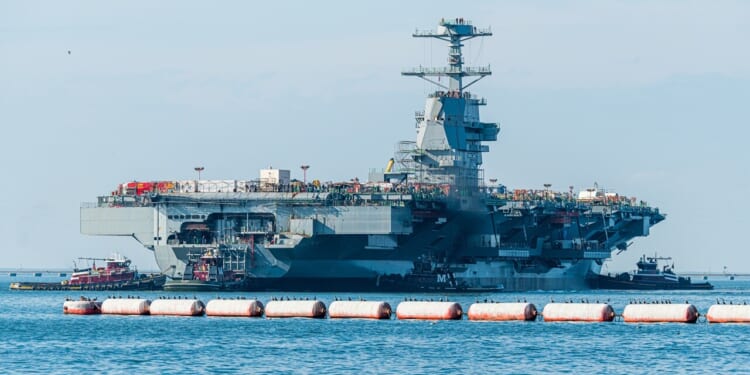Because of delays in the JFK’s delivery, the US Navy will be short a carrier for nearly a year—at precisely the moment China will be ready to attack Taiwan.
In late September of this year, Newport News Shipbuilding (HII) confirmed that the newest Ford-class aircraft carrier, USS John F. Kennedy (CVN-79), had conducted its first nuclear propulsion trials in the James River. During that process, tugboats moved her off the pier, turned her, tested shafting, then returned her to the dock.
This is a big deal for the United States Navy, as well as for America’s aircraft carrier force, which is in dire need of the newest carrier. By conducting this test late last month, the Navy validated that the core powerplant and shaft machinery are functioning under real conditions, moving the ship one step closer to full deployment.
Some Background on America’s Next Aircraft Carrier
Last year, CVN-79 began topside testing of its new Electromagnetic Aircraft Launch System (EMALS)—first “no-load” launches, then “dead-load” launches (simulating aircraft weights of up to around 80,000 pounds). The launches were executed off the mighty new warship’s bow. The tests were meant to confirm that the catapult system, which has given the Navy many problems over the years, works under realistic loads and conditions.
But the JFK has been giving the Navy fits before it even leaves the shipyards. The total procurement cost for CVN-79 was capped at $11.4 billion, though the Navy’s Fiscal Year 2024 budget estimated the procurement cost at $12.7 billion (in 2024 dollars). That figure, by the way, represents a 15 percent drop from the cost of the JFK’s sister ship, the Gerald R. Ford.
The Pentagon argues that each new Ford-class carrier will get progressively cheaper. Even if that holds true, though, the technical challenges involved in the construction of these highly complex vessels is almost not worth the cost.
Originally slated for delivery around July 2025, the schedule radically shifted due to unforeseen complications in the construction of the new carrier. As such, the new delivery date has been pushed back to March 2027. As a reminder, its sister ship and namesake of the new carrier class, the USS Gerald R. Ford (CVN-78), was similarly delayed from its original launch date by two years—from 2015 pushed back to 2017.
The Navy has attributed the delays for the John F. Kennedy to continued work on—and the need for certification for—key systems like the Advanced Arresting Gear (AAG) and Advanced Weapons Elevators (AWE). These two critical systems have been hugely problematic for the entire Ford-class of carriers—which are supposed to replace the aging Nimitz-class aircraft carriers, but cannot due to these persistent technical complications.
Meanwhile, America’s enemies, notably China, continue advancing at breakneck speeds in ways that are specifically aimed at stunting the power projection capabilities of all US carriers. To overcome these woes, the Navy is having to determine if they can afford to wait until the JFK is a fully mature system before putting it to sea, or if they will need to embrace the “good enough to sail, then upgrade” model that the US Air Force has had to embrace with their expensive systems.
But there are clear downsides to that latter model of deployment—especially when one factors into account the exorbitant cost of the Ford-class carriers.
Is the JFK a Cutting-Edge Ship—or a Complicated Mess?
Although CVN-79 is around 95 percent structurally complete, all the new, whiz-bang gadgetry incorporated into the design of this carrier is not yet ready for showtime. That’s what is holding up the deployment of this massive ship. Even though the ship’s launch date has been pushed back by two years, the continuing complications of weapons elevators and other advanced systems are holding it back.
The Ford class utilizes electromagnetic linear synchronous motor elevators, as opposed to traditional cable/pulley elevators. The Navy claims that the EM systems they’ve incorporated into the basis of the Ford-class carriers are foundational for an entirely new generation of US aircraft carriers. Naval planners intend for those EM systems, if they prove successful, to enable future integration of higher-power weapons like directed energy weapons (DEWs) or railguns—giving the Navy real growth margin in the rapidly accelerating high-tech weapons race with China and Russia.
Because the USS Nimitz (CVN-68) is scheduled for retirement in May 2026, and the John F. Kennedy won’t be delivered until at least 2027, the Navy’s carrier fleet will temporarily drop to just ten operational carriers for nearly a year. That gap is politically and operationally sensitive, particularly because the Pentagon believes that the Chinese will be ready for an attack on Taiwan at around that time.
In fact, Beijing might even be aligning their plans for Taiwan around the fact that Uncle Sam is dedicated to its deactivation timeline for the Nimitz whilst its activation of the JFK is wildly off-schedule—meaning that the Navy’s global force will be strained and stretched and, quite possibly, could be broken by a well-timed Chinese thrust into the First Island Chain.
Could the JFK Be Delayed Even Further?
If all goes well, the USS John F. Kennedy will usher in a leap in US carrier capabilities—but the next 18 months will be make-or-break for the carrier. For strategic planners, it’s not just a ship launching. This is a test of whether the United States Navy can manage modernization cycles under immense pressure, maintain operational posture, and retain its qualitative edge over enemies who are increasingly catching up to the Americans and figuring out innovative ways to stymie the potency of the US flattop.
So the coming months will prove critical for determining if the John F. Kennedy will make its new delivery date of March 2027. The Navy must watch closely for whether CVN-79 will clear the thresholds demanded for their AAG and AWE systems’ certifications—and how many iterations of tests will be needed to meet those requirements. Once propulsion, catapults, arresting gear, sensors, and combat systems are fully integrated, how robust will the sea trials for the ship be?
If there are many more schedule readjustments, such interim, or partial, deliveries, that might mean delays beyond March 2027. And if there are more complications and, therefore, delays, will that bring greater scrutiny from Congress and pressure to reduce scope, cut funding, or reprioritize naval programs?
All these are at stake with the newest Ford-class carrier yet again slipping behind its original delivery date.
About the Author: Brandon J. Weichert
Brandon J. Weichert is a senior national security editor at The National Interest. Recently, Weichert became the host of The National Security Hour on America Outloud News and iHeartRadio, where he discusses national security policy every Wednesday at 8pm Eastern. He is also a contributor at Popular Mechanics and has consulted regularly with various government institutions and private organizations on geopolitical issues. Weichert’s writings have appeared in multiple publications, including The Washington Times, National Review, The American Spectator, MSN, The Asia Times, and others. His books include Winning Space: How America Remains a Superpower, Biohacked: China’s Race to Control Life, and The Shadow War: Iran’s Quest for Supremacy. His newest book, A Disaster of Our Own Making: How the West Lost Ukraine is available for purchase wherever books are sold. He can be followed via Twitter @WeTheBrandon.
Image: Shutterstock / Greg Meland.
















